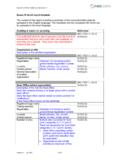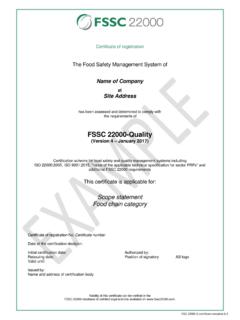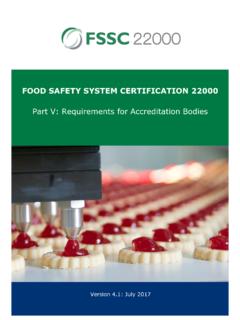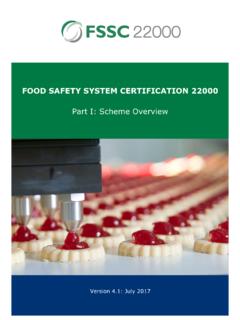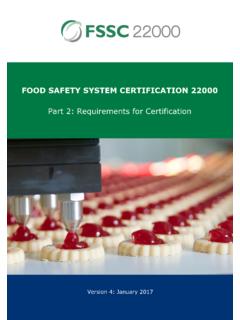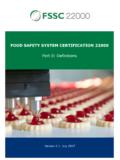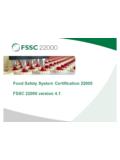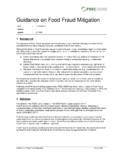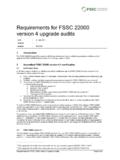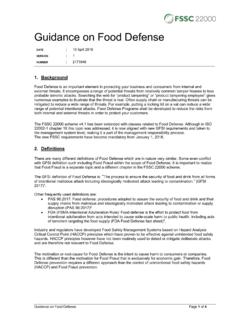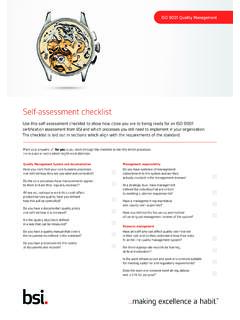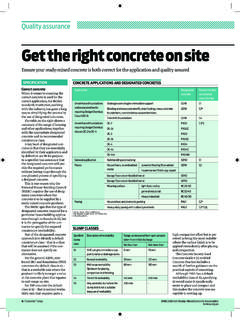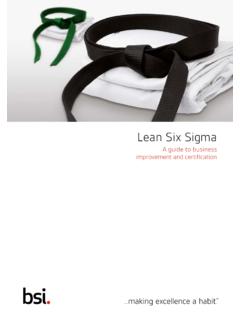Transcription of FOOD SAFETY SYSTEM CERTIFICATION 22000
1 food SAFETY SYSTEM CERTIFICATION 22000 Part II: Requirements for CERTIFICATION Version : July 2017 Part II: Requirements for CERTIFICATION Version July 2017 1 of 7 Part II: Requirements for CERTIFICATION Contents 1 Purpose .. 3 food categories and sectors .. 3 Field of application .. 3 2 Outline of Scheme requirements .. 4 Main components .. 4 ISO 22000 .. 4 ISO 9001 .. 4 Prerequisite Programs (PRP) .. 4 Additional requirements .. 5 Management of services .. 5 Product labelling .. 6 food defense .. 6 Threat assessment .. 6 Control measures .. 6 Plan .. 6 food Fraud prevention .. 6 Vulnerability assessment .. 6 Control measures .. 6 Plan .. 6 Logo use .. 6 Management of allergens (for categories C, I and K only).
2 7 Environmental monitoring (for categories C, I and K only) .. 7 Formulation of products (for category DII only) .. 7 Management of natural resources (for category A only) .. 7 Part II: Requirements for CERTIFICATION Version July 2017 2 of 7 Copyright 2017, Foundation FSSC 22000 All rights reserved. No part of this publication may be reproduced and/or published in any form, by means of printed matters, photocopy, microfilm, recording or any other method or technology, without written approval by the Foundation FSSC 22000 . Foundation FSSC 22000 Box 693 4200 AR Gorinchem, The Netherlands Phone +31 183 645028 Website: Email: Part II: Requirements for CERTIFICATION Version July 2017 3 of 7 1 Purpose This document states the requirements to be included in the design and implementation of the food SAFETY Management SYSTEM claimed to conform with the requirements of the Scheme by an applicant/certified organization seeking to be included in the FSSC 22000 Register of Certified Organizations.
3 food categories and sectors The following food chain categories and related supply chain sectors fall within the Scheme scope of CERTIFICATION : Category Sub-category Supply chain sector food SAFETY / Quality Management SYSTEM Pre-requisite programs Additional requirements A AI Farming of animals for meat/milk/eggs/honey ISO 22000 :2005 / ISO 9001:2015 ISO/TS 22002-3:2011 See for applicability AII Farming of fish and seafood ISO 22000 :2005 / ISO 9001:2015 ISO/TS 22002-3:2011 See for applicability C CI Processing of perishable animal products ISO 22000 :2005 / ISO 9001:2015 ISO/TS 22002-1:2009 See for applicability CII Processing of perishable plant products ISO 22000 :2005 / ISO 9001:2015 ISO/TS 22002-1:2009 See for applicability CIII Processing of perishable animal and plant products (mixed products) ISO 22000 :2005 / ISO 9001:2015 ISO/TS 22002-1:2009 See for applicability CIV Processing of ambient stable products ISO 22000 :2005 / ISO 9001:2015 ISO/TS 22002-1:2009 See for applicability D DI Production of animal feed ISO 22000 :2005 / ISO 9001:2015 ISO/TS 22002-6:2016 (BSI/PAS 222:2011*) See for applicability DII Production of pet food for dogs and cats ISO 22000 :2005 / ISO 9001:2015 ISO/TS 22002-1 See for applicability DII Production of pet food for other pets than dogs and cats ISO 22000 :2005 / ISO 9001:2015 ISO/TS 22002-6:2016 (BSI/PAS 222.)
4 2011*) See for applicability E N/A** Catering ISO 22000 :2005 / ISO 9001:2015 ISO/TS 22002-2:2013 See for applicability F FI Retail ISO 22000 :2005 / ISO 9001:2015 BSI/PAS 221:2013 See for applicability G GI Provision of transport and storage services for perishable food and feed ISO 22000 :2005 / ISO 9001:2015 NEN/NTA 8059:2016 See for applicability GII Provision of transport and storage services for ambient food and feed ISO 22000 :2005 / ISO 9001:2015 NEN/NTA 8059:2016 See for applicability I N/A** Production of food and feed packaging and packaging material ISO 22000 :2005 / ISO 9001:2015 ISO/TS 22002-4:2013 See for applicability K N/A** Production of (bio)chemicals ISO 22000 :2005 / ISO 9001:2015 ISO/TS 22002-1:2009 See for applicability * The BSI/PAS 222:2011 standard shall no longer be used after January 1, 2018 ** N/A = Not Applicable Field of application The Scheme requirements are global in nature, applicable to organizations in the food and feed supply chain regardless of their size and complexity, whether profit-making or not and whether public or private.
5 Part II: Requirements for CERTIFICATION Version July 2017 4 of 7 2 Outline of Scheme requirements This section provides an outline of the Scheme requirements to be met in order to achieve CERTIFICATION . Main components The Scheme requirements consist of separate components that shall be audited as a single SYSTEM : 1) ISO 22000 :2005 food SAFETY management SYSTEM requirements. 2) ISO 9001:2015 quality management systems requirements when selected (FSSC 22000 Quality). 3) Sector specific pre-requisite programs (PRPs) requirements. 4) Additional requirements. The following clauses provide a brief commentary on each component and state the high level requirements to be met for each. ISO 22000 The requirements for the development, implementation and maintenance of the food SAFETY management SYSTEM are laid down in the standard ISO 22000 :2005 food SAFETY management systems - Requirements for any organization in the food chain.
6 To facilitate the successful implementation of a food SAFETY management SYSTEM , the operational conditions of the food SAFETY management SYSTEM shall be specified, documented and verified. ISO 9001 For FSSC 22000 -Quality CERTIFICATION , all ISO 9001:2015 Quality Management SYSTEM requirements are applicable in addition to the Scheme requirements. Prerequisite Programs (PRP) ISO 22000 requires in clause that organizations shall select and implement specific PRPs for basic hygiene conditions. Organizations establishing, implementing and maintaining these PRPs shall consider other appropriate information and utilize it accordingly. Such information shall include: a) regulatory requirements; b) recognized sector or product group codes of practices and guidelines; c) customer requirements.
7 To facilitate the successful implementation of the food SAFETY management SYSTEM , the conditions of the PRPs shall be; a) specified, b) documented, c) approved and d) verified. ISO 22000 :2005 does not specify these requirements as the standard is applicable to the whole food chain and the basic hygiene requirements may vary considerably between sectors. In order to clarify the requirements for PRPs and to allow for recognition by the Global food SAFETY Initiative (GFSI) of the Consumer Goods Forum, industry stakeholders have Part II: Requirements for CERTIFICATION Version July 2017 5 of 7 developed detailed technical specifications covering sector pre-requisite programs (PRPs). These technical specifications are used in addition to ISO 22000 to provide an agreed interpretation.
8 Exceptions shall be justified and documented where PRP requirements are deemed not to be applicable in relation to the scope of the organization s activities and verified during an audit. FSSC 22000 provides a CERTIFICATION Scheme for sectors where such a technical specification for sector PRPs has been integrated as described in the scope (see table 1 above). Additional requirements To meet the needs of the key stakeholders and to ensure an adequate control of food SAFETY , specific additional FSSC requirements for the food SAFETY management SYSTEM are included in the Scheme. These may be elaborations of the clauses in ISO 22000 :2005 and technical specifications for sector PRPs or additional requirements as outlined below.
9 The additional Scheme requirements are: 1) Management of services, 2) Product labelling, 3) food defense, 4) food fraud prevention, 5) Logo use, 6) Management of allergens (for categories C, I and K only), 7) Environmental monitoring (for categories C, I and K only), 8) Formulation of products (for category DII only), 9) Management of natural resources (for category A only). Management of services 1) The organization in the food chain shall ensure that all services that may have an impact on food SAFETY : a) have specified requirements which are regularly reviewed, b) are described in documents to the extent needed to conduct hazard analysis, c) are managed in conformance with the requirements of technical specification for sector PRPs, d) are assessed and approved demonstrating compliance with specified requirements, e) are monitored to assure continued service provider approval status.
10 2) The services referred to in 1) above shall include at least: a) utilities, b) transport and storage, c) maintenance, d) cleaning and e) outsourced services. 3) The organization shall implement a SYSTEM to assure that when analysis critical to the verification of food SAFETY is undertaken, this is conducted by a competent laboratory that has the capability to produce precise and repeatable test results using validated test methods and best practices ( successful participation in proficiency testing programs, regulatory approved programs or accreditation to international standards such as ISO 17025). Part II: Requirements for CERTIFICATION Version July 2017 6 of 7 Product labelling The organization shall ensure that the finished product is labelled according to the applicable food regulations in the country of intended sale.
